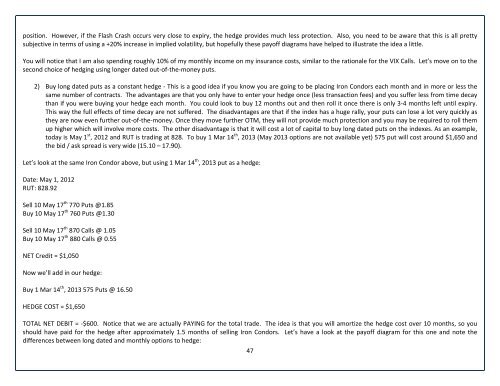Bullshit Free Guide to Iron Condors - Options trading IQ
Bullshit Free Guide to Iron Condors - Options trading IQ
Bullshit Free Guide to Iron Condors - Options trading IQ
Create successful ePaper yourself
Turn your PDF publications into a flip-book with our unique Google optimized e-Paper software.
position. However, if the Flash Crash occurs very close <strong>to</strong> expiry, the hedge provides much less protection. Also, you need <strong>to</strong> be aware that this is all pretty<br />
subjective in terms of using a +20% increase in implied volatility, but hopefully these payoff diagrams have helped <strong>to</strong> illustrate the idea a little.<br />
You will notice that I am also spending roughly 10% of my monthly income on my insurance costs, similar <strong>to</strong> the rationale for the VIX Calls. Let’s move on <strong>to</strong> the<br />
second choice of hedging using longer dated out‐of‐the‐money puts.<br />
2) Buy long dated puts as a constant hedge ‐ This is a good idea if you know you are going <strong>to</strong> be placing <strong>Iron</strong> <strong>Condors</strong> each month and in more or less the<br />
same number of contracts. The advantages are that you only have <strong>to</strong> enter your hedge once (less transaction fees) and you suffer less from time decay<br />
than if you were buying your hedge each month. You could look <strong>to</strong> buy 12 months out and then roll it once there is only 3‐4 months left until expiry.<br />
This way the full effects of time decay are not suffered. The disadvantages are that if the index has a huge rally, your puts can lose a lot very quickly as<br />
they are now even further out‐of‐the‐money. Once they move further OTM, they will not provide much protection and you may be required <strong>to</strong> roll them<br />
up higher which will involve more costs. The other disadvantage is that it will cost a lot of capital <strong>to</strong> buy long dated puts on the indexes. As an example,<br />
<strong>to</strong>day is May 1 st , 2012 and RUT is <strong>trading</strong> at 828. To buy 1 Mar 14 th , 2013 (May 2013 options are not available yet) 575 put will cost around $1,650 and<br />
the bid / ask spread is very wide (15.10 – 17.90).<br />
Let’s look at the same <strong>Iron</strong> Condor above, but using 1 Mar 14 th , 2013 put as a hedge:<br />
Date: May 1, 2012<br />
RUT: 828.92<br />
Sell 10 May 17 th 770 Puts @1.85<br />
Buy 10 May 17 th 760 Puts @1.30<br />
Sell 10 May 17 th 870 Calls @ 1.05<br />
Buy 10 May 17 th 880 Calls @ 0.55<br />
NET Credit = $1,050<br />
Now we’ll add in our hedge:<br />
Buy 1 Mar 14 th , 2013 575 Puts @ 16.50<br />
HEDGE COST = $1,650<br />
TOTAL NET DEBIT = ‐$600. Notice that we are actually PAYING for the <strong>to</strong>tal trade. The idea is that you will amortize the hedge cost over 10 months, so you<br />
should have paid for the hedge after approximately 1.5 months of selling <strong>Iron</strong> <strong>Condors</strong>. Let’s have a look at the payoff diagram for this one and note the<br />
differences between long dated and monthly options <strong>to</strong> hedge:<br />
47


